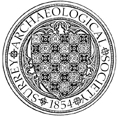121 London Road, Ewell
Evaluation by J Robertson of SCAU, for the Surrey Community Development Trust, in advance of residential development revealed no features, and only three fragments of post-medieval tile and a possible struck flint flake. No signs were encountered of Stane Street, previously thought to cross the site, and the possibility of an alternative route for the road in this vicinity now needs to be considered.


